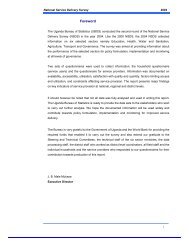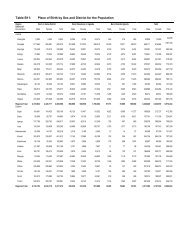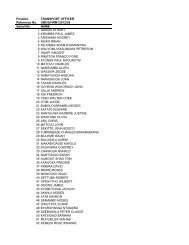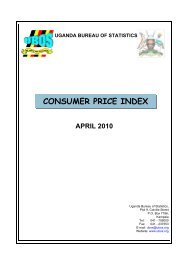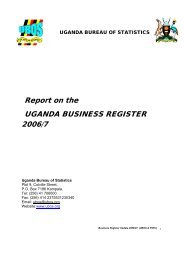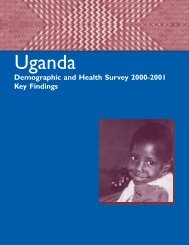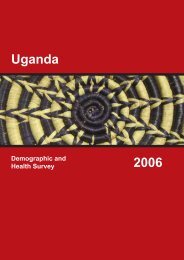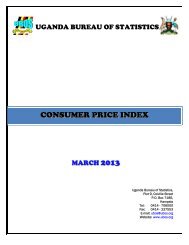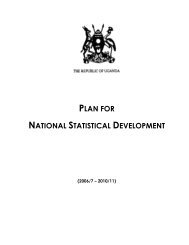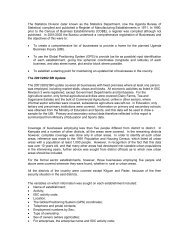Nature, Distribution and Evolution of Poverty & Inequality in Uganda
Nature, Distribution and Evolution of Poverty & Inequality in Uganda
Nature, Distribution and Evolution of Poverty & Inequality in Uganda
- No tags were found...
You also want an ePaper? Increase the reach of your titles
YUMPU automatically turns print PDFs into web optimized ePapers that Google loves.
Concepts, methods <strong>and</strong> data2.4 <strong>Poverty</strong> gap measureThe poverty <strong>in</strong>cidence measure does not <strong>in</strong>dicatehow poor the poor are. It does not dist<strong>in</strong>guishbetween a household whose consumption levelsare very close to the poverty l<strong>in</strong>e <strong>and</strong> a householdwhose consumption levels are far below it. Ifpeople below the poverty l<strong>in</strong>e were to becomepoorer, this measure does not change. The povertygap measure overcomes this problem.The poverty gap provides <strong>in</strong>formation onthe depth <strong>of</strong> poverty. It captures the averageexpenditure shortfall, or gap, for the poor <strong>in</strong> agiven area to reach the poverty l<strong>in</strong>e. The povertygap is obta<strong>in</strong>ed by add<strong>in</strong>g up all the shortfalls <strong>of</strong>the poor (ignor<strong>in</strong>g the non-poor) <strong>and</strong> divid<strong>in</strong>gthis total by the number <strong>of</strong> poor. It measures thepoverty deficit <strong>of</strong> the population or the resourcesthat would be needed to lift all the poor <strong>in</strong> thatarea out <strong>of</strong> poverty, if one were able to perfectlytarget cash transfers towards clos<strong>in</strong>g the gap. Inthis sense, the poverty gap is a very crude measure<strong>of</strong> the m<strong>in</strong>imum amount <strong>of</strong> resources necessary toeradicate poverty, i.e. the amount <strong>of</strong> money thatwould have to be transferred to the poor to liftthem up to the poverty l<strong>in</strong>e, under an assumption<strong>of</strong> perfect target<strong>in</strong>g.To demonstrate, aga<strong>in</strong> us<strong>in</strong>g Northern Region asan example, results <strong>of</strong> this analysis suggest that<strong>in</strong> 2002 the poverty gap for the rural population<strong>in</strong> Northern Region was 24.3% (UBOS 2003). Thisimplies that, on average, every poor person <strong>in</strong> arural area <strong>in</strong> the Northern Region would requirean additional UShs 5,071 per month to reach thepoverty l<strong>in</strong>e (i.e. 24.3% <strong>of</strong> the UShs 20,872 ruralpoverty l<strong>in</strong>e). Thus, if 65% <strong>of</strong> the rural populationwas poor (accord<strong>in</strong>g to the headcount <strong>in</strong>dex) <strong>in</strong>2002, imply<strong>in</strong>g roughly 3.1 million poor people<strong>in</strong> Northern Region, approximately UShs 15.8billion (US$ 8.7 million) per month would havebeen needed, <strong>in</strong> perfectly targeted cash transfers,to eradicate rural poverty <strong>in</strong> Northern Ug<strong>and</strong>a <strong>in</strong>2002.The poverty gap for Northern Region at the subcountylevel is shown <strong>in</strong> Map 2.3. The green areasshow relatively low poverty gaps <strong>and</strong> the greyshad<strong>in</strong>g <strong>in</strong>dicates high poverty gaps. The highestpoverty gap is found <strong>in</strong> Lopei (55%) <strong>in</strong> MorotoDistrict. This implies that, on average, every poorperson <strong>in</strong> this region would require an additionalUShs 11,508 per month to reach the poverty l<strong>in</strong>e.Therefore, to pull all the poor people (30,558)<strong>in</strong> this sub-county (with an overall population<strong>of</strong> 31,182 people <strong>and</strong> poverty rate <strong>of</strong> 98%) to thepoverty l<strong>in</strong>e would require UShs 352 million (US$193,646; 1US$ = UShs. 1816) per month. Decisionmakers could use this <strong>in</strong>formation to identify areas<strong>of</strong> deep (or shallow) poverty <strong>and</strong> to estimate howmuch it would cost to raise st<strong>and</strong>ards <strong>of</strong> liv<strong>in</strong>g <strong>in</strong>such areas.However, like the head count <strong>in</strong>dex or poverty<strong>in</strong>cidence, the poverty gap measure has someshortcom<strong>in</strong>gs. First, it is neither practical norfeasible to reach the whole population throughperfectly targeted cash transfers. Second, it doesnot measure <strong>in</strong>equality among poor people, i.e.the fact that some people might only be a fewshill<strong>in</strong>gs short <strong>of</strong> the poverty l<strong>in</strong>e while othersmight only have a few shill<strong>in</strong>gs to spend. The G<strong>in</strong>icoefficient is a measure that captures this range<strong>in</strong> people’s expenditures/<strong>in</strong>comes, i.e. it is a proxyfor <strong>in</strong>come <strong>in</strong>equality.16 <strong>Nature</strong>, distribution <strong>and</strong> evolution <strong>of</strong> poverty <strong>and</strong> <strong>in</strong>equality <strong>in</strong> Ug<strong>and</strong>a, 1992 - 2002



